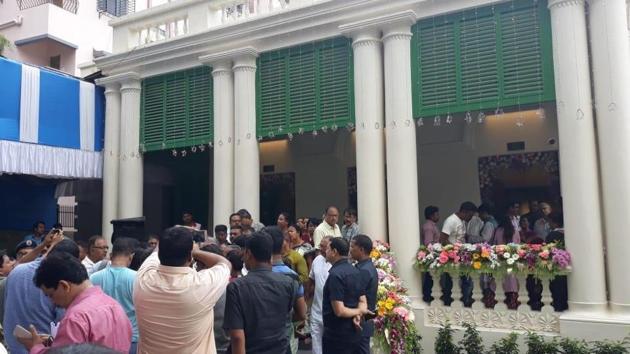Gandhi Jayanti 2019: Hyderi Manzil, where Gandhi spent August of 1947 to stop Kolkata killings
Gandhi spent 25 days at Hyderi Manzil and fasted indefinitely to bring an end to killings in Bengal, the worst during Independence. The house, now known as Gandhi Bhawan was protected by Jugal Chandra Ghosh, who had laid down arms at Gandhi’s feet, for a long time.
Tucked in the middle of a concrete jungle, a single-storied and recently renovated British-era house at Beliaghata in the eastern fringe of Kolkata came alive on Wednesday with a Bengal minister and followers of Mohandas Karamchand Gandhi gathering in numbers to pay tribute on his 150th birth anniversary.

This building that stands witness to a dark episode in the city’s 300-year-old history was home to Gandhi from August 13 to September 7, 1947, while he strove to end the worst communal killings during Independence. The bloodbath marked the creation of East Pakistan which became Bangladesh after the Liberation War of 1971. Gandhi Bhawan continues to remind people of the price a nation had to pay for its freedom.
Called Hyderi Manzil since the 1920s and later christened Gandhi Bhawan by local people, the building, with a floor area of 400 square metres, stands on a 1000-square-metre plot guarded by high walls. It was teeming on Wednesday with fresh paint and other renovations including a Gandhi-bust. Though, not the best looking part of Kolkata, it definitely appears to be part of a growing city. But this was not how Gandhi saw it.
“Hyderi Manzil had been abandoned long before 1947. Parts of the structure were dilapidated. There was not even a road leading to its entrance. Shrubs and trees were quickly removed to prepare a pathway and only one room, out of the eight, was cleaned up so that Gandhi could stay,” said Papri Sarkar, joint secretary of Purba Kolkata Gandhi Smarak Samity, a body formed by local followers of Gandhi who have been looking after the building for decades.
According to old records, the property was purchased by members of the Dawoodi Bohra community who came from Surat in the mid-1800s for business in Calcutta, then capital of British India. Sheikh Adam, a member of the community, later inherited Hyderi Manzil and passed it on to his daughter. The family however shifted elsewhere.
Beliaghata was primarily a Muslim neighbourhood and went by the name Mianbagan. In 1946, it was the epicenter of the riots, later known as the Great Calcutta Killings because thousands of lives were lost. Similar riots took place in Noahkhali (now in Bangladesh). The clashes continued till September 1947.
Muslim League leader Huseyn Shaheed Suhrawardy was accused by the All India Hindu Mahasabha and other Hindu organisations of masterminding the attacks. Suhrawardy demanded an undivided free state of Bengal, which had a sizeable Muslim population, and opposed the creation of East Pakistan and West Bengal.
Suhrawardy’s principal opponent was Hindu Mahasabha president Shyama Prasad Mookerjee who told Lord Mountbatten, the Viceroy, that Bengal must be divided even if India was not.
The riots were on when Gandhi arrived in Bengal on August 9, 1947. Suhrawardy was head of the Bengal provincial government.
Gandhi was keen on visiting Noahkhali but Suhrawardy and Congress leaders requested him to stay back in view of the communal tension in the city. Gandhi agreed but asked Suhrawady to join the peace process and insisted on staying among the Muslims. Gandhi walked into Hyderi Manzil on August 13 amid demonstration by angry Hindus who shouted anti-Gandhi slogans and waved black flags. On August 15, Gandhi spent the day fasting and praying. In no time, Hyderi Manzil turned into the most visited house in the city with students, politicians and intellectuals pouring in to meet Gandhi. But the peace was short-lived.
Communal riots resumed on August 31and Gandhi went on an indefinite fast the next day, saying the killings had to stop for good. He did not give in to requests from West Bengal governor C Rajagopalachari. Finally, on September 4, some leaders of the warring groups came to Gandhi and surrendered their weapons at his feet. After spending 25 days at Hyderi Manzil, Gandhi left for Delhi on September 7.
“One of the Hindus who laid down his sword before Gandhi was Jugal Chandra Ghosh. After that day, Ghosh became a Gandhian and protecting Hyderi Manzil became his mission,” said Sarkar.
“Over the years, we set up a museum where Gandhi’s letters, some of his belongings, items he used during the say, photographs, some of those swords et al were put up as exhibits. We were immensely helped by Gopal Krishna Gandhi (Gandhi’s grandson) when he served as a governor between 2004 and 2009,” she added.
The erstwhile Left Front government took over the property in 1985 and renovated it. The Trinamool Congress government declared it a heritage site in 2012.
Interestingly, the longest resident of the building since Independence is its caretaker Dilip Dey who was appointed in 1990 by Jugal Chandra Ghosh. “I was around 20 at that time. We all revered him (Ghosh) and called him ‘Dadu’ (grandfather). One day he said, ‘Why don’t you do something fruitful?’ and offered me ₹200 a month. Since that day, Gandhi Bhawan has been my life. Dadu passed away in 2002,” said Dey.
This was Gandhi’s last visit to Kolkata. He came to the city for the first time in 1896 and spent only a day. Between 1896 and 1947 he visited Bengal 64 times and spent 566 days.






